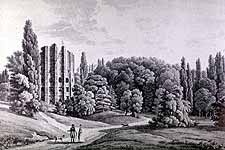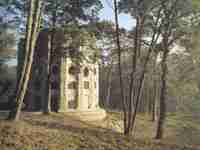|
Welcome to the Racine de Monville Home Page, the world's first website devoted to the Désert de Retz, the most romantic folly garden in Europe.
The Désert de Retz is the best surviving example of the eighteenth-century Jardin Anglo-chinois, or folly garden, and was designed and constructed between 1774 and 1789 by a wealthy aristocrat, François Racine de Monville. In eighteenth-century France, the term "désert" referred to an isolated, deserted place or a place with only a sparse population.
Located on the edge of the Forêt de Marly in the community of Chambourcy, approximately 20 kilometers west of Paris [geographical coordinates Lat: 48.8897990 Lon: 2.0170960], the Désert de Retz originally extended over forty hectares and contained a botanical garden including rare and exotic varieties of trees, ornamental plants and flowers that Monville imported from around the world; a kitchen garden, and a dairy farm. This map of the Désert de Retz as it existed in 1785 shows the original extent of Monsieur de Monville's property. Today the western half of the estate has been converted into a golf course. In addition, Monville constructed seventeen structures known as follies or fabriques. Reflecting the 18th century interest in antiquity, these included an ice-house in the form of a pyramid, an Egyptian obelisk, and a temple dedicated to the Greek god Pan. The hightened interest in the Orient led Monville to construct a Chinese house (the first in Europe), and a Tartar tent on an Island of Happiness.
The most remarkable of the fabriques, however, was Monsieur de Monville's Column House. It was a false ruin 50 feet high in the shape of a truncated section of a gigantic Tuscan column, evoking the glories of ancient Rome. One of the few examples of 18th century visionary architecture to actually be constructed, the Column House contained a ground floor and three upper stories. The interior of Column House was divided into oval rooms whose walls were decorated with Toile de Jouy; upper floors were reached by a spiral staircase illuminated by a glass skylight. Rare plants and flowers were hung along the banisters. The Column House was used as a summer home by Monsieur de Monville, and remains the outstanding feature of the Désert and one of the most unusual residences in Europe. The Désert de Retz was open to the public and Monsieur de Monville received many famous personalities as his guests, including Queen Marie Antoinette, Benjamin Franklin, Thomas Jefferson and King Gustavus III of Sweden. In the twentieth century, the Désert de Retz intrigued André Breton and his Surrealist friends, who congregated there. It also inspired Collette's Paradis Terrestre. Artists' continuing fascination with the garden has made the Desert de Retz one of the most consistently documented gardens in history. In the 1930's, however, after serving as a commercial dairy, the garden was abandoned and went into a long period of decline. A number of the fabriques, most lamentably the Chinese House, deteriorated to such an extent that they disappeared entirely.
In recent years, the Désert de Retz has become a cause celèbre en France. After decades of neglect and depredation, the Désert was saved in extremis by the direct intervention of the French government. Crumbling buildings were shored up and ambitious plans were made to restore the Désert to its original spendor.
Many famous persons have become interested in the Désert and visited the garden: artists Salvador Dali, Louis Aragon and Jean [Hans] Arp in 1927, author André Pieyre de Mandiargues in 1946, the Duke and Duchess of Windsor in 1950, André Breton and 23 other surrealists in 1960, Jacqueline Kennedy Onassis in 1979, former President Jimmy Carter in 1983, President François Mitterand in 1990, and the architect I. M. Pei in 1994. The reknowed French actress Madeleine Renaud was a neighbor and often visited the Desert de Retz.
On September 17, 1989, as part of the annual European Heritage Day activites, then-Minister of Culture, Jack Lang, accompanied the media and a group of visitors on a tour of the Desert de Retz. Watch the
video from the archives of the Institut National de l'Audiovisuel (INA) showing several of the buildings (Quicktime, running time 00:02:13).
Scenes from at least three films have been shot at the Desert de Retz. In 1923 French direcor Abel Gance used the Desert de Retz as a decor for his film Au Secours!, starring Max Linder and Harry Houdini. In June 1994 several scenes from director James Ivory's film Jefferson in Paris, starring Nick Nolte, Greta Scacchi and Jean Pierre Aumont, were shot on location at the Désert de Retz. Alas, for the time being, further restorations are stymied by a complicated lawsuit and visits have been suspended. The Racine de Monville Home Page also contains an extensive chronology of the extraordinary life of the creator of the Desert de Retz, François Henri Racine de Monville, with sources.
Twenty-five photographs of the Désert de Retz taken between 1976 and 2008 are located on the Photos page. In addition, you can read the latest news from France, in a continuously updated news feed and link directly to the principal French daily newspapers. The Francophilia page contains over 50 carefully selected links of interest to francophiles and francophones and the Gardens page has links to landscape architecture and gardening sites. Purchase books about Désert de Retz on the Shop page and save 30%. The Search page offers links to the Web's best search engines inclding Google, Ixquick, Vivisimo and FAST. There is also a sonnet written one of the owners of the Desert de Retz with links to online translators. Dominique Césari has created a very comprehensive site about
folly gardens in France and elsewhere in Europe. The site includes a page devoted to the Désert de Retz with a map of the garden as well as numerous original photographs and reproductions of
five rare monochrome postcards depicting the Desert de Retz in the early 20th century. In September, 2007, Alexander Trevi, a landscape architect working and living in Chicago, posted some of Michael Kenna's photographs and other photographs as well as some personal observations about the Desert de Retz on his blog Pruned: On Landscape Architecture and Related Fields. September 27:The Broken Column House, September 28: A Pyramid for Serving Glaciers, September 30: At the Gates of the Desert. The Getty Research Institute has created a virtual exhibition, Irresistible Decay: Ruins Reclaimed. "Ruins are both symbols of decay and emblems of continuity over time. From the early 1500s to the contemporary period, images of ruins have occupied a central place in our collective imagination. They provoke reactions ranging from nostalgia to foreboding, from dreams of grandeur to fears of mortality." The virtual exhibition includes two engravings of the Column House at the Desert de Retz, reproduced from the series published by George Le Rouge in 1785; a general view and a cross section. This beautiful winter view of the Temple of Pan is by Michael Kenna, whose photographs illustrate Diana Ketcham's book about the Désert de Retz. Links to more photographs of the Desert de Retz by Michael Kenna can be found on the Photos page. Kirk Johnson has an article on Jardins Anglo-chinois on his Garden Design site. He places the Désert de Retz in a historical context. The Wikipedia has entries on the Désert de Retz in
English and
French.
The table below shows all the owners of the Desert de Retz, from its origin in 1774 to the present.
If you would like to learn more about the Désert de Retz or join the mailing list, see the Contact page.
Please address any comments or questions about this site to the webmaster. Click on this link to send your email: I hope you enjoy this site. |


